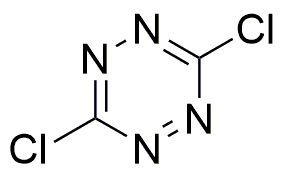3,6-Dichloro-1,2,4,5-tetrazine is widely utilized in research focused on:
- Explosive Materials: This compound is often used in the development of high-energy materials and explosives due to its ability to release a significant amount of energy upon decomposition.
- Propellant Formulations: It serves as a key ingredient in solid rocket propellants, enhancing performance and stability compared to traditional compounds.
- Analytical Chemistry: Researchers employ it in various analytical techniques to detect and quantify other substances, benefiting from its unique chemical properties.
- Organic Synthesis: It is utilized in the synthesis of other complex organic molecules, making it valuable in pharmaceutical and agrochemical research.
- Material Science: The compound is explored for its potential applications in creating advanced materials with specific thermal and mechanical properties, outperforming similar compounds.
General Information
Properties
Safety and Regulations
Applications
3,6-Dichloro-1,2,4,5-tetrazine is widely utilized in research focused on:
- Explosive Materials: This compound is often used in the development of high-energy materials and explosives due to its ability to release a significant amount of energy upon decomposition.
- Propellant Formulations: It serves as a key ingredient in solid rocket propellants, enhancing performance and stability compared to traditional compounds.
- Analytical Chemistry: Researchers employ it in various analytical techniques to detect and quantify other substances, benefiting from its unique chemical properties.
- Organic Synthesis: It is utilized in the synthesis of other complex organic molecules, making it valuable in pharmaceutical and agrochemical research.
- Material Science: The compound is explored for its potential applications in creating advanced materials with specific thermal and mechanical properties, outperforming similar compounds.
Documents
Safety Data Sheets (SDS)
The SDS provides comprehensive safety information on handling, storage, and disposal of the product.
Product Specification (PS)
The PS provides a comprehensive breakdown of the product’s properties, including chemical composition, physical state, purity, and storage requirements. It also details acceptable quality ranges and the product's intended applications.
Certificates of Analysis (COA)
Search for Certificates of Analysis (COA) by entering the products Lot Number. Lot and Batch Numbers can be found on a product’s label following the words ‘Lot’ or ‘Batch’.
*Catalog Number
*Lot Number
Certificates Of Origin (COO)
This COO confirms the country where the product was manufactured, and also details the materials and components used in it and whether it is derived from natural, synthetic, or other specific sources. This certificate may be required for customs, trade, and regulatory compliance.
*Catalog Number
*Lot Number
Safety Data Sheets (SDS)
The SDS provides comprehensive safety information on handling, storage, and disposal of the product.
DownloadProduct Specification (PS)
The PS provides a comprehensive breakdown of the product’s properties, including chemical composition, physical state, purity, and storage requirements. It also details acceptable quality ranges and the product's intended applications.
DownloadCertificates of Analysis (COA)
Search for Certificates of Analysis (COA) by entering the products Lot Number. Lot and Batch Numbers can be found on a product’s label following the words ‘Lot’ or ‘Batch’.
*Catalog Number
*Lot Number
Certificates Of Origin (COO)
This COO confirms the country where the product was manufactured, and also details the materials and components used in it and whether it is derived from natural, synthetic, or other specific sources. This certificate may be required for customs, trade, and regulatory compliance.


